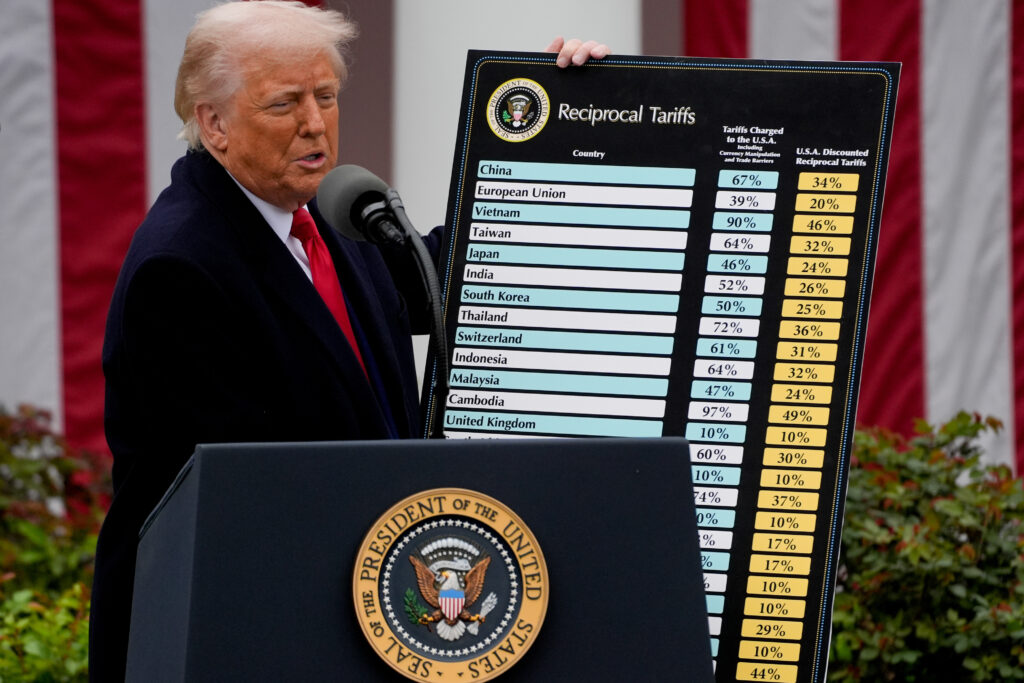Interviews / Political and Geostrategic Observatory of the United States
17 June 2025
Trump and His Trade War: Between Economic Failures and Political Calculations

Excessive tariffs, threats of sanctions, bilateral trade agreements, the revaluation of currencies in surplus countries… The decisions made by Donald Trump in his second term are redrawing the map of global economic balances as he targets traditional allies with an aggressive protectionist policy. To what extent can the effectiveness of these economic pressure tools be questioned in light of past experiences? Are these decisions the product of economic adventurism or the outcome of a clearly defined political line? What impact will this tariff war have on global balances? Economist Philippe Barbet, Emeritus Professor at Université Sorbonne Paris Nord and Associate Research Fellow at IRIS, offers his analysis.
Donald Trump’s protectionist ambitions were wide-ranging at the outset of his second term. Was this assertive policy unprecedented in the history of the United States? In a context of increasing interdependence, is the imposition of high tariffs still an effective tool of power?
The United States has always maintained a complex relationship with openness to international trade. Like many countries now considered developed (Japan, South Korea, Germany, France, etc.), the take-off of the American economy was achieved through strong protection of its infant industries, such as steel. The theory of “infant industries” developed by German economist Friedrich List in 1841 was widely adopted by Alexander Hamilton in his 1791 report on manufacturing presented to Congress. Influenced by Colbert’s approach in France, he advocated a combination of tariffs and subsidies for emerging industries considered strategic. This so-called “educational” protectionism was, however, not intended to last and was supposed to be phased out once the American industry emerged from its initial stage of development.
The increase in tariffs decided by the current U.S. administration does not follow this tradition. It rather resembles, with significant tariffs in the steel sector (rising from 25% initially to 50%), a form of protection for an ageing industry that happens to be located in swing states—states whose voters fluctuate between Republicans and Democrats.
President Trump, moreover, did not refer to Alexander Hamilton at his inauguration, but rather to President McKinley, elected in 1896, who raised average tariffs from 38% to around 50%. This increase, decided at the time partly to boost federal government revenues, did not have the expected effect, as McKinley himself acknowledged shortly before his assassination in 1901.
The next wave of protectionism in the U.S. came in the 1930s with the Hawley-Smoot Act, which raised tariffs and, due to retaliatory measures from partner countries, contributed to the spread of the deep economic crisis that subsequently affected both sides of the Atlantic.
The U.S. accession to the General Agreement on Tariffs and Trade (GATT) in 1947 ushered in a long period of tariff reductions, followed by the dismantling of non-tariff barriers to trade (quotas, import contingents, protectionist use of standards, etc.). During the second half of the 20th century, U.S. trade policy focused more on defending specific sectors deemed strategic. Disputes multiplied with the United States’ main trading partners—particularly with Japan in the automotive and electronics sectors, and with the European Union in the protracted Airbus–Boeing conflict over the commercial aircraft market. The steel industry, increasingly uncompetitive in the U.S., was also subject to multiple protectionist measures, both tariff and non-tariff.
At the same time, bilateralism has prevailed in trade relations and conflicts at the expense of the multilateral logic of the GATT and later the World Trade Organization (WTO, 1995), which has received diminishing support from the U.S. The WTO’s dispute settlement body, which resolves trade disputes between member states, has in fact been paralysed since 2011 due to the U.S. refusal to appoint a judge, thus undermining the organisation’s ability to regulate international trade.
Nevertheless, tariffs and most protectionist measures remained established on a multilateral and non-discriminatory basis—identical regardless of the United States’ trading partners. It is this very principle that has now been abruptly called into question by the current administration.
Are the rollbacks on tariffs imposed on China and the delay of new levies on EU products evidence of a well-defined political strategy by Donald Trump, or do they reveal economic amateurism, as some have suggested?
It is important to remember that under the American Constitution, the President is responsible for foreign policy, while Congress handles trade policy. However, as these two domains often intertwine, conflicts between the executive and legislative branches have been frequent, with a historical trend towards presidential dominance in trade matters.
Formalised by the Trade Act of 1974, U.S. trade policy is regularly revised. Under this law, several provisions (notably Sections 232 and 301) allow the executive to impose retaliatory tariffs on countries deemed to have unfair trade practices. Yet, these measures are subject to oversight and are typically temporary. Despite this framework, the question of legislative versus executive authority remains ongoing, as demonstrated by a case filed in May 2025 by five American importers to the U.S. Court of International Trade. They challenged the legality of the President’s use of the International Emergency Economic Powers Act to raise general tariffs—an authority constitutionally vested in Congress. The complaint argues that U.S. trade deficits have persisted for decades and that an emergency justification is unwarranted.
The executive branch has been highly assertive since the 2024 election, with the most significant trade decisions announced spectacularly by President Trump. Tariffs—which had fallen to minimal levels and were no longer prominent in international trade negotiations—are now back centre stage in U.S. policy. The President views them as a panacea for multiple issues: boosting public revenues (presented as a tax paid by foreign firms to enter the U.S. market), replacing income tax, punishing “unfair” partners like China and the EU, retaliating against nations failing to control fentanyl entry (Mexico and Canada), and incentivising foreign firms to relocate to the U.S. to create jobs. Aligning these objectives poses a formidable challenge.
Let us illustrate with the first objective: raising tariff revenues. Very high tariffs drastically reduce imports and thus narrow the base for tariff income. The case of China is instructive: tariffs were progressively escalated, reaching 145% in April 2025, prompting a Chinese response capping tariffs at 125%. At such levels, trade volume collapses—and with it, tariff receipts in the U.S. budget. Moreover, consumer prices soar, and incentives emerge to bypass these tariffs via third countries, further undermining revenue generation. In response, tariffs were temporarily reduced to 10%, with an additional 20% surcharge on goods linked to fentanyl trafficking, to aid negotiations between the two countries.
The implementation of so-called reciprocal or bilateral tariffs—meaning different tariffs depending on the trading partner—was explained in a surprising way using a chart presented by the American president at the White House, which left most economists perplexed. It is worth recalling that the very principle of reciprocal tariffs fundamentally contradicts the previous logic, which was based on multilateral negotiations and resulted in uniform product-by-product tariffs for all partners, thus prohibiting any form of discrimination.
The tariffs presented country by country are calculated, roughly speaking, by dividing the trade surplus of each country with the United States by its total exports. The resulting percentage is then halved, out of “kindness”, to determine the tariff rate applied to foreign products entering the United States from each respective country. This approach assumes that the U.S. trade deficit with all its partners stems from unfair practices that need correcting. However, bilateral trade deficits are primarily due to the weak competitiveness of goods manufactured in the United States. Furthermore, focusing solely on the trade deficit ignores the trade in services (software, audiovisual, etc.) in which the United States holds a significant surplus.
Looking at the first half of Trump’s second term, it appears that tariffs have been presented as a cure-all solution to various problems affecting the American economy. The dramatic announcements and subsequent backtracking suggest they are more a bargaining chip to obtain concessions from partners than a goal in themselves. The true effectiveness of these measures will likely only become evident once negotiations have concluded.
What is the impact of Donald Trump’s policy on the American economy? More broadly, where is the U.S. President’s trade war policy leading the world? To what extent are we witnessing a disruption of the global economic order?
The U.S. economy is structurally in deficit, both in terms of trade and budget. In 2024, the trade deficit reached nearly $920 billion, an increase of 17% compared to the previous year. Meanwhile, the budget deficit stood at $1.877 trillion, representing 6.2% of GDP. The trade policy pursued by the Trump administration aims to reduce imports through high tariffs, to negotiate an increase in U.S. exports—such as natural gas to Europe—and to ease fiscal constraints by increasing customs revenues.
According to Antoine Bouët, Director of the Centre for Prospective Studies and International Information (CEPII), the consequences of this trade policy for the U.S. economy are likely to be negative. Higher tariffs will be passed on to the prices of imported goods, fuelling inflation. American companies that incorporate imported components into their production cycles will face higher production costs and a decline in competitiveness. Finally, the multiple U-turns in trade policy create instability and may discourage investors from setting up operations in the United States, thereby undermining the administration’s stated objectives.
The impact of U.S. policy on other countries’ economies is not negligible but should not be overstated. The U.S. economy accounts for 25% of global GDP and 13% of world trade. However, global trade is increasingly concentrated within large regional blocs that primarily trade amongst themselves. For instance, 70% of European exports are destined for other European countries, compared to 51% for Asia and 38% for North America. While the United States is undoubtedly a major economic actor, its withdrawal from international trade rules can be circumvented. The erratic trade policy of the U.S. administration, by contrast, highlights the existence of a pole of stability committed to a minimum level of rules—namely, the European Union.
Given that major breakthroughs in multilateral trade liberalisation seem unlikely in the short term with a paralysed World Trade Organization (WTO), it may be time for Europe to firmly commit to concluding trade agreements with major partners, such as Latin American countries grouped under Mercosur, other North American states, and countries across Asia and the Pacific.

